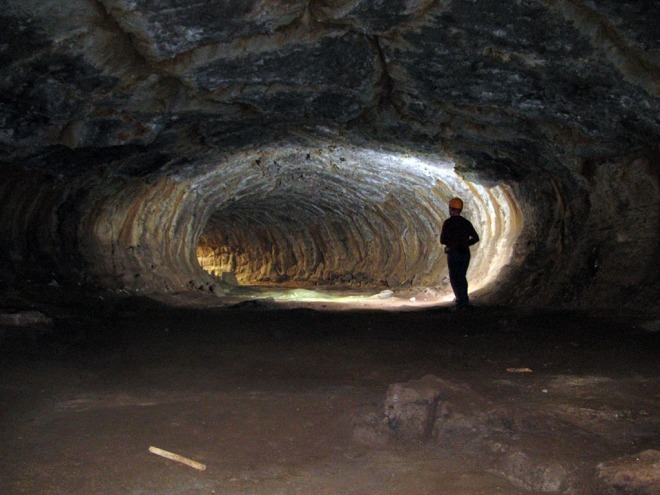Solutional Cave –
These caves are the most commonly occurring (How Limestone Caves Are Formed). They generally form in soluble rock such as limestone but can form from other rocks such as chalk, dolomite, marble, salt, and gypsum (How Limestone Caves Are Formed). The rocks of these caves are dissolved by natural acid in groundwater as it seeps through joints and faults (How Limestone Caves Are Formed). Eventually, cavities form in the rock and continue to grow, becoming large and hollow (How Limestone Caves Are Formed). These cavities can be found at varying depths in a cave system due to the continual seepage and flow of the mildly acidic water through the deposits (How Limestone Caves Are Formed).
 Image URL: http://www.maropeng.co.za/content/page/how_limestone_caves_are_formed>
Image URL: http://www.maropeng.co.za/content/page/how_limestone_caves_are_formed>
In most cases, solutional caves are composed of limestone because of its tremendous abundance and its susceptibility to carbonic acid which forms when rainwater mixes with CO2 and organic acids (How Limestone Caves Are Formed). Moreover, underground rivers can be quite common in caves (How Limestone Caves Are Formed). These rivers form when the water table is above portions of the cave because it floods these areas (How Limestone Caves Are Formed). Naturally, if there is enough water and the right conditions, a river will be created as it flows downhill and towards areas of lower pressure (How Limestone Caves Are Formed).
Primary Cave –
These caves form at the same time as the surrounding rock (Types of Caves). For instance, lava tubes are primary caves because they form at the same time as the surrounding rock. After a volcanic eruption, lava flows downhill (Types of Caves). This lava quickly cools and solidifies (Types of Caves). Hot liquid lava continues to flow under that crust, and if most of it flows out, a hollow tube remains (Types of Caves).
 Image URL: https://cavern.com/Learn/cavetypes.asp
Image URL: https://cavern.com/Learn/cavetypes.asp
Sea Cave –
These caves are found along coasts (Types of Caves). A special type of this type of cave are littoral caves (Types of Caves). These cave forms due to the areas of weakness in seacliffs being smashed by waves (Types of Caves).

Erosional Cave –
These caves form from the erosional power caused by streams (Types of Caves). These caves are comprised of all types of rock, even hard granite (Types of Caves). However, there must be a weakness to guide the water such as a fault or joint (Types of Caves).
Glacier Cave –
“Glacier caves are formed by melting ice and flowing water within and under glaciers” (Types of Caves).
Fracture Cave –
The materials that make up the layers are soluble minerals such as gypsum (Types of Caves). When these layers dissolve out between layers of more soluble rock, there becomes a hollow area that will eventually become the cave (Types of Caves). These caves eventually form from the fracture and collapse in blocks of stone (Types of Caves).
Talus Cave –
These caves form from openings among large boulders that have fallen into massive piles, usually off of cliffs (Types of Caves). It is called a talus cave because the deposits of these boulders are called “talus”( Types of Caves).
Anchialine Cave –
Anchialine caves are usually coastal, containing a mixture of freshwater and salt water, (Types of Caves). “They occur in many parts of the world, and often contain highly specialized and endemic fauna” (Types of Caves).
Clarksville Cave
The cave we explored was a solutional cave, the most common type of cave. One obvious reason it is a solutional cave is because there was an abundance of limestone. Limestone is a very soluble substance and is therefore weak against carbonic acid, which ultimately creates the cave. Another feature we saw in the cave were faults and joints, a necessary feature for a limestone cave because it is the main way groundwater enters the cave. A bonus feature we saw in the cave that is common for solutional caves are rivers. Rivers form in caves when the water table is above the level of the cave. Lastly, the presence of a sinkhole showed this cave is a solutional cave because the dissolution of rock from carbonic acid creates sinkholes.